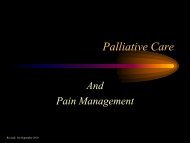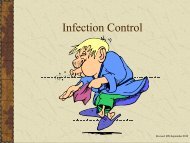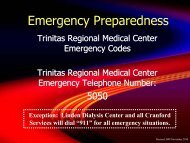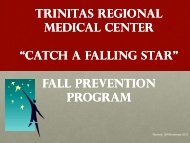Fire Safety - Trinitas Hospital
Fire Safety - Trinitas Hospital
Fire Safety - Trinitas Hospital
Create successful ePaper yourself
Turn your PDF publications into a flip-book with our unique Google optimized e-Paper software.
<strong>Fire</strong> <strong>Safety</strong><br />
Revised: BW/September 2010
<strong>Fire</strong> <strong>Safety</strong>~<br />
The First 3 Minutes Are Critical<br />
<strong>Fire</strong> is fast – and spreads quickly:<br />
Keep stairways, hallways and fire exits clear from<br />
obstruction-ALWAYS<br />
Investigate any suspicious smell or smoke at once.<br />
If you think there may be a fire behind a door,<br />
feel the door with the back of your hand first.<br />
If the door is hot to the touch DO NOT open it.<br />
Don’t Panic! Remain Calm! Walk, do not run!
Remember:<br />
You Are In a “R.A.C.E.” For <strong>Safety</strong><br />
RESCUE<br />
ALARM<br />
CONFINE<br />
EXTINGUISH/EVACUATE
RESCUE<br />
Rescue patients in immediate<br />
danger:<br />
Stay calm to reassure the<br />
patient.<br />
Remember, heat and smoke<br />
will rise towards the ceiling.<br />
Stay low to the ground<br />
during the rescue.
ALARM<br />
Don’t hesitate to sound the alarm:<br />
Do not yell “<strong>Fire</strong>”. Remain calm.<br />
Act as a team – while one person pulls the<br />
alarm or calls the Emergency number (5050),<br />
the others can rescue patients in danger.<br />
Do not hang up the phone before asking the<br />
party at the other end to repeat the location of<br />
the fire.
CONFINE<br />
<strong>Fire</strong> doors will close automatically to keep the<br />
fire from spreading.<br />
Always keep doorways clear;<br />
do not prop fire doors open.<br />
Close all doors and windows.<br />
Stuff wet towels under doors<br />
to keep smoke out.<br />
Shut off oxygen supply valves if instructed<br />
to do so.
EXTINGUISH<br />
If the fire is small and<br />
confined, you may:<br />
Smother the fire with a pillow,<br />
towel or blanket.<br />
If a patient’s clothes are on fire,<br />
smother the flames with a large<br />
blanket.<br />
If a piece of equipment is on<br />
fire, pull the plug if possible.<br />
ONLY if safety<br />
permits: Use<br />
P.A.S.S. to operate<br />
a fire extinguisher.
Using a <strong>Fire</strong> Extinguisher: Remember<br />
P.A.S.S.<br />
Pull the pin between the two handles<br />
Aim the nozzle at the base of the fire<br />
Squeeze the handles together<br />
Sweep the nozzle side to side.<br />
Continue to spray the fire even after the flames<br />
are out.<br />
Stay near the extinguished fire, if possible, until<br />
the fire department arrives.
P.A.S.S.<br />
PULL the pin<br />
AIM<br />
LOW at the base of the fire<br />
4/1/2002 (c)Virginia ARES / RACES - All Rights Reserved - <strong>Fire</strong><strong>Safety</strong> 32<br />
4/1/2002 (c)Virginia ARES / RACES - All Rights Reserved - <strong>Fire</strong><strong>Safety</strong> 33<br />
SQUEEZE<br />
the lever<br />
SWEEP<br />
from side to side<br />
4/1/2002 (c)Virginia ARES / RACES - All Rights Reserved - <strong>Fire</strong><strong>Safety</strong> 34<br />
4/1/2002 (c)Virginia ARES / RACES - All Rights Reserved - <strong>Fire</strong><strong>Safety</strong> 35
Types of <strong>Fire</strong> Extinguishers:<br />
Class A:<br />
use on ordinary combustible<br />
materials such as paper.<br />
Class B:<br />
use on flammable liquids or<br />
gasses, such as gasoline or<br />
kerosene.<br />
Class C:<br />
use on fires that are in or near<br />
electrical equipment, such as<br />
switches and computers<br />
Class ABC:<br />
can be used on<br />
all 3 types of fires.
If Evacuation Becomes Necessary:<br />
Evacuate ambulatory patients first.<br />
Horizontal evacuation first – through the<br />
fire doors into a safe area on the same floor.<br />
Vertical evacuation is used only if your way is<br />
blocked by smoke or flames.<br />
Never use elevators to evacuate.<br />
Non-ambulatory patients:<br />
Evacuation chairs-located throughout units on<br />
both campuses’.<br />
Can be moved via wheelchairs or stretchers if<br />
necessary.<br />
Two people can use the swing carry or two man single-file<br />
carry to move patients to safety.
Key <strong>Fire</strong> <strong>Safety</strong> Points<br />
All employees should be aware of:<br />
The location of primary and secondary exits if<br />
applicable.<br />
Location of fire extinguishers<br />
Location of the evacuation plan<br />
Types of ignitable materials located in your<br />
department<br />
Location of nearest pull station<br />
All electrical equipment must be approved by the<br />
Engineering or Biomedical Department










